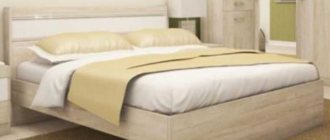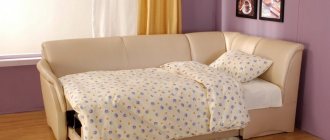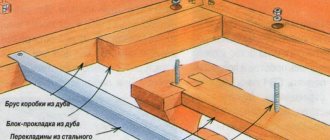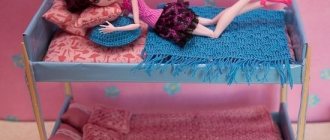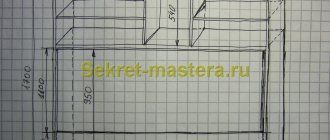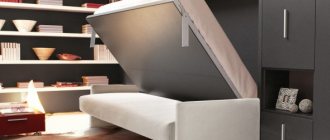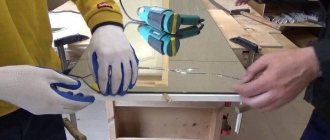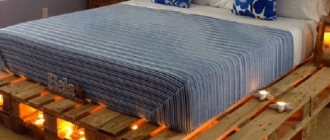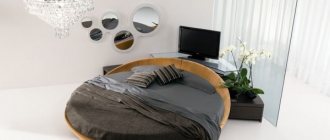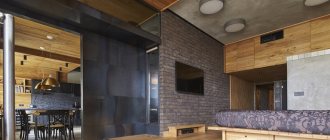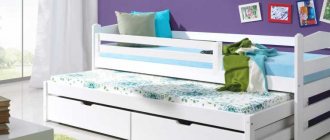A wrapped bed in the interior of bedrooms creates a special atmosphere of peace and comfort. Strict and sophisticated upholstery covers the bed on all sides, providing the possibility of endless combinations of colors and textures. This direction of furniture design has gained great popularity.
Features of soft tunic beds
A draped soft bed is distinguished by the fact that all structural elements are draped - headboard, footboard, frame. Even the inside of the laundry box is lined.
Natural and eco-leather looks noble, fabric draperies are warm and cozy. Upholstery materials with dust- and moisture-repellent impregnations fully ensure the hygiene of the bedroom and are easy to care for. The under-bed box has plenty of storage space for bedding items
Fabric bed
The bedroom should be cozy and comfortable, because only here a person can relax as much as possible after numerous daily worries. A bed upholstered in fabric is 100% up to this task. You can not only sleep well in it, but also happily take a nap on your day off, read a book or watch a movie, comfortably leaning on the soft surface of the backrest.
How a soft bed works
The soft enveloped bed is an orthopedic structure consisting of the following elements:
- welded metal or wooden frame with slats or a solid base;
- framed with wooden sides (sidewalls), creating a 6-10 cm nest for an orthopedic mattress;
- spacious under-bed linen drawer with legs or reaching to the floor.
The upholstery of the sides prevents the use of drawers. A convenient solution was a soft bed with a lifting base on coil springs, with gas or hydraulic lifts.
Chrome legs with plastic inserts that protect the floor from scratches and dents. A headboard and footboard may be present, but are not always included in the set.
What upholstery materials are used when upholstering soft beds?
Upholstered beds are decorated with genuine leather, luxury eco-leather, and high-strength fabrics. Genuine leather requires special care and respect. All artificial materials are endowed with water-repellent properties and do not accumulate dust and dirt. They are easy to care for and durable.
To successfully choose a soft bed, you need to pay attention not only to the beauty of the upholstery, but also to its quality characteristics. Although the cost of reliable drapery is sometimes half the price of the bed, it is better not to skimp. Thin fabrics and cheap leatherette without protective impregnations will quickly fade, wear out, and tear.
In order for a wrapped bed to delight you with its beautiful appearance for 15-20 years, you should pay attention to these types of upholstery.
- Velsoft, Softness – soft velor fabrics, pleasant to the touch. The pile and base are resistant to abrasion and tearing. The rubber layer retains the attractiveness of the upholstery for a long time. Antistatic impregnation repels dust.
- Cotton, linen are natural fabrics reinforced with water- and dirt-repellent impregnations.
- Valencia is a high-quality durable leatherette. The Quick&Clean polymer coating prevents the accumulation of dirt and is easy to clean.
- Tapestry, jacquard - dense textiles with a large pattern. The base is made of silk and wool fibers. Withstands dry and wet friction, sun rays due to the admixture of polyester.
- Chenille is a durable fabric made from fibers twisted with pile. It is distinguished by long-term color and wear resistance.
- Eco-leather is soft, delicate, elastic, with a matte shine, resistant to scratches, cracking, and abrasion.
The upholstery is decorated with embossing and stitching. The convex carriage tie is tightened with buttons and rhinestones. Volume overlays add softness.
The color range includes dozens of shades. The advantages of each are emphasized by carved wooden and forged metal frames with gilding, silvering, patina, inlay, metal plates on the corners of the base, contrasting edgings, and twisted cords. In some models, the covers on the drawers can be removed and replaced with others.
Soft bed fillers
Foam rubber and polyurethane foam are mainly used as upholstery fillers. These materials are not highly durable, but they are not required for the headboard, base, or footboard.
In the finishing of luxury-class beds, the prestige of which is natural materials, under the upholstery they put underlays made of wool, latex, and plant fibers.
How the frame of soft tufted beds works
The bed frame consists of an under-bed box, sometimes with 1-2 stiffening ribs for heavy weight. A base for the mattress is installed on it in the form of a metal or wooden frame with slats. In some models, the under-bed box is the same size as the lifting base. In others it may be wider, forming a small protrusion around the perimeter.
Inexpensive frames are made of chipboard, fiberboard, MDF. They are lighter than natural wood, but the glue that binds the fine wood fraction is not always safe. Be sure to ask the seller for a quality certificate.
Expensive frames are made from beech, oak, and pine. Slats are preferably made of flexible and durable birch and beech plywood. The soft double bed has a lattice of double slats in double rubber lat holders.
Bed and base
When choosing a sleeping place, along with the visual effect, it is necessary to take into account comfort. The standards provide for a bed length that is 20 cm greater than a person’s height. The width is selected so that 10 cm of free space remains from the bent elbows of one or two people.
Manufacturers of upholstered beds have taken care of a diverse range of sizes:
- single models – 80-90x190-200 cm;
- one and a half – 120-140x190-200 cm;
- double – 160-200x190-220 cm;
- king size – 200x200-220 cm.
The height of the bed consists of a base height of 29-33 cm and a mattress thickness of 18-28 cm. The sleeper is high enough so that he is not disturbed by the cold air above the floor.
The bases are removable and built-in. The frame with slats on the lifting mechanism can be removed if necessary for repair or replacement, as can individual battens. In some models, the lattice is built into the frame mattress.
It is better to choose metal frames with an anti-corrosion coating, wooden ones - with antifungal impregnation.
For heavier people, a solid base will last longer. There are models where a sheet of plywood is laid on a grid of lamellas. It does not interfere with orthopedic springiness and does not allow the mattress to deform.
Headboards of soft beds - types and features
The headboard of an upholstered bed is always the central focus. Furniture makers show their imagination in various configurations:
- asymmetrical;
- in the form of corner backs;
- high up to 150 cm and low meter;
- with a difference in height on 2 halves of a wide bed.
As an option, it is possible to mount it to the wall or install it in special grooves in the bed. A long headboard on the wall looks luxurious. It is conveniently adjacent to a sleeping place and bedside tables lined with leather.
A headboard that slightly overhangs or flows around the pillow area on the sides creates a feeling of privacy and security. In a single style solution, a low backrest is made in the legs.
A wrapped bed surrounds a tired body with softness and warmth. Draped corners protect against hard contacts that leave marks. Matte surfaces do not irritate with annoying glare and scorching cold. A soft bed muffles sounds, soothes, quietly taking you into the world of dreams.
How to upholster with fabric: master class
Below we discuss upholstery methods for different headboard options, as well as different upholstery methods.
Large rectangular
A rectangular headboard is the easiest to restore and decorate. It is enough to choose the fabric for the upholstery, as well as stock up on foam rubber and padding polyester. Instructions:
- place the backrest on the foam rubber, cut around the perimeter;
- Apply construction adhesive to the headboard and press down the foam;
- At the top end, sew the foam rubber with a stapler;
- lay the padding polyester with an allowance of 7–8 cm at the edges;
- lay the upholstery, tuck the edges with padding polyester from the top, and staple to the base;
- Sew the bottom end in the same way, fix the fabric on the sides;
- cut triangles of fabric at the corners and secure with a stapler.
This finishing option is the simplest. It is enough to monitor the tension of the fabric so that there are no ties or distortions. If possible, ask a friend for help.
Figured
Upholstering a shaped headboard is a little more difficult, but only because it will take more time. The procedure is no different from standard upholstery, but has a number of features:
- the foam rubber must be cut to the shape of the headboard (curly), so it is more convenient to use tailor’s scissors instead of a stationery knife;
- padding polyester or batting is also laid on top of the foam rubber, which is fixed along the contour of the part with a stapler until the required shape is achieved;
- the lower end of the back is usually straight, so start from there: lay the fabric on the lining, stitch with a stapler from the back side;
- do the same with the sides, cutting off the fabric in the lower corners - only the upper curly end will remain to be covered with fabric;
- act progressively: place staples through every centimeter of fabric, make cuts in places of bends so that the upholstery is more pliable;
- after covering, the back side of the back will look unaesthetic: this can be corrected by sewing mesh lining fabric or any other fabric.
Advice
Stock up on anti-stapler in advance. When working with a shaped headboard, you will often need to remove the brackets to adjust the upholstery.
Angular
There are different ways to use the free space in a room. Often the bed is placed in a corner to free up space. These can be either regular rectangular beds or corner models. Here it is reasonable to stylize the corner as a sleeping place, designing a corner headboard for better positioning of the sleeping area.
Peculiarities:
- you will need to measure the width and length of the bed to determine the angle parameters for decoration;
- Based on the parameters of the bed, prepare two plywood, chipboard, fiberboard or a pair of wooden panels (longitudinal and transverse);
- in the case of standard upholstery, it is enough to reupholster the sheets by covering the sheets with foam rubber, padding polyester and fabric;
- for the carriage screed, diamond-shaped markings are made on plywood;
- at the intersections of the diamonds, holes are drilled to adjust the fittings and fabric;
- You can secure the plywood to the wall with screws, bolts, nails or a profile;
- To increase the strength of the structure, glue is used in corner joints (preferably epoxy).
Attention
A corner headboard will likely require drilling into the wall. It is irrational to attach such a headboard to the bed because of its heaviness.
With decorative trim
Products covered with leather or fabric are usually decorated with decorative nails or rivets. This headboard takes on a finished look and looks aesthetically pleasing. The main constriction is carried out according to the general principle. Markings for future decor should be done on the finished back, which is covered with fabric.
- Make the necessary indentation along the edges. To do this, it is convenient to use a triangular ruler.
- Use a pencil to mark the places where the outermost nails will be driven in.
- Install the nails and stretch a thick thread between them.
- Measure the width of the marking: this way you will understand at what step it is better to install the fittings.
- Mark with a pencil all places for installing parts.
- Then you just need to install the nails according to the markings and hammer them in with a hammer.
Reference
Upholstery with decorative trim looks good on both rectangular and shaped headboards.
Sheathing with carriage tie
The carriage tie is most popular when covered with leather. However, the quilted effect can be achieved even with the help of other upholstery fabric. Additional accessories and tools will be required: decorative buttons, round drill. Instructions:
- cut the foam around the perimeter of the back, glue it with mounting glue;
- wait until the glue sets (5–7 minutes), turn the part with the foam over;
- Use a pencil to mark under the screed, keeping 5–7 cm margins along the edges;
- Drill holes at the intersections of the diamonds: this is where the fittings will be installed;
- to draw holes on the foam rubber, remove the needle and thread and make a mark;
- drill holes in the foam using a round drill;
- fix the padding polyester with a stapler, make indentations in the holes (press your fingers on the padding polyester at the drilling sites);
- Apply identical markings to the reverse side of the leather, thread the threads where they align with the holes;
- lay the skin on the foam rubber, pull the threads through the holes and pull it tight, fix it on the back side with a stapler;
- stitch the leather along the edges of the headboard, starting from the top end and ending with the sides;
- Thread the threads into the legs of the buttons, pull them out into the holes on the headboard, and sew them on the back side with a stapler.
Attention
The thickness of the foam rubber for the carriage screed must be at least 50 mm. It is not necessary to lay synthetic padding under natural leather, but it is recommended.
The video shows how to cover the headboard with a carriage screed:
How to make upholstery on the back side?
- A mesh lining fabric (perforated) of the desired shade is attached to the back side of the headboard. It hides the aesthetic imperfections of the covering, protects the wood and joints from damage. It is necessary to cut the fabric with 2-3 cm indentations along the edges of the headboard so that there is enough of it to cover the stitching.
- Fold the edges and secure with pins for convenience.
- Secure the material with a stapler around the perimeter of the back.
- Alternatively, the fabric is secured with small nails. Then the seam seems neater.
Types of backrests, materials and tools, as well as rules for making headboards are described in detail here.
Let's figure out together how to choose a high-quality crib and assemble it yourself. We will find out what the rules and schemes for assembling cribs with an attic, playpen and pendulum are, as well as what advice experts give for assembling a structure called “Dolphin”. You can also read separately about how to remake a sleeping bed with your own hands - increase the size, strengthen the structure, cover the headboard and paint it a different color.
Upholstering a headboard is easy to do and the results will bring joy to any bedroom owner. You can revive old furniture, create a unique thing that has no analogues. To do this, you will need a minimum of tools and the help of a close friend, because any work moves faster in a team.
Photos of soft beds in the interior
<
>
Choosing the right wrapped bed means getting complete rest, restoring your supply of energy and vigor for the next day.
Which fabric is best for bed upholstery?
When choosing upholstery fabric for a bed, it is not enough to rely only on your own taste. It is better to understand the characteristics of the various options and compare them. It is important to consider the conditions in which the bed will stand. Each person may have their own priorities in the properties of the fabric, not least of which is the price. Typically chosen based on appearance, durability, functionality, style, design, feel, and ease of care.
A bed with soft textile upholstery is always an island of comfort in the home. A correctly selected design will decorate any bedroom interior. You simply cannot find a better place for good sleep and relaxation!
Criterias of choice
The main criteria for choosing a fabric: composition, design, density, resistance to abrasion, fire resistance, resistance to sunlight, breathability, environmental friendliness, presence of additional impregnation, ease of cleaning, peelability.
The textile industry produces a huge number of different fabrics, which differ in color, composition, texture and other properties. There is a list with a detailed description of the markings. Let's look at it in detail.
There are 7 categories into which furniture fabrics for sofa upholstery are divided:
They are used on rarely used furniture, as they can withstand 5 thousand cycles of use according to the Martindell test.
Scotch guard, chinille fabrics, cotton, and thermal jacquard are marked with this number.
Durability - 7 thousand cycles. The material is not used for upholstering sofas in the kitchen or children's room.
Jacquard, corduroy, flock. In terms of density they correspond to category No1, but with increased strength and resistance to mechanical damage. Complete abrasion after 10-12 thousand cycles of use.
Dense, thick fabrics with a non-standard type of weaving. Strong, wear-resistant. Loss of strength after 15 thousand cycles.
Tapestry, patterned suede, bouclé chenille. Very durable. The usage limit is 18 thousand cycles.
The upholstery fabric for sofas marked N5 is dense, there is a lining layer or natural fibers are added, which extend the service life to 22 thousand cycles of active use.
Substitute leather - Arpatek, nanoleather, eco-leather. Up to 45-50 thousand cycles according to wear resistance tests.
All leather of various types of tanning. Upholstery material for a sofa from this category is considered the best. Available with additions in the form of various patterns.
The highest level of abrasion resistance is from 50 thousand Martindale cycles.
Also pay attention to where the furniture is used, because each room is used with different frequency. The place where the furniture is used is an important point that decides what fabric to choose for the upholstery.
Living room
The sofas in this room should be upholstered with wear-resistant materials, category no less than 5, and ease of maintenance is encouraged. It is best to choose boucle, microfiber, leather substitute, flock, and other synthetic fabrics - they are impregnated with dirt-repellent impregnations and are easy to clean.
Bedroom
The fabric for upholstering the sofa in this room should not be impregnated with chemical compounds; preference is given to natural materials that are pleasant to the touch. The composition must contain at least 50% natural fibers. A good option is tapestry, jacquard, velor.
Kitchen
The specifics of this room oblige the use of coatings for reupholstering furniture that are easy to clean from dirt and grease, are fire-resistant, and do not absorb liquids and odors. Eco-leather is the optimal solution when choosing furniture for the kitchen. Also used for upholstery of kitchen furniture is firecard, finely fleecy velor.
Children's room
Linen, cotton and wool meet all the necessary requirements for a nursery. They are environmentally friendly, natural, do not cause allergic reactions and do not contain chemical additives.
You can reupholster the sofa in this room with flock or microfiber.
So how to choose eco-leather?
The basis
- Artificial leather on a non-woven basis is used for decorative and solid furniture elements - armrests, bottom of the base, back wall, legs.
- Leatherette on a woven basis is suitable for covering soft elements - seats, headboards of sofas and armchairs. The woven base does not burst under load.
Compound
The main advantage of PVC leather is strength. The material can be placed on all parts of upholstered furniture. Vinyl leather is almost not vulnerable to tears and stretching, but can become deformed when exposed to the sun for a long time, because ultraviolet light evaporates the polymer. When choosing, take into account the thickness of the PVC layer and the quality of the warp threads, since the reliability of the product depends on this.
Polyurethane leathers are not as durable as PVC leathers. Therefore, despite the presence of a woven base, PU leather has limitations in applicability. If it is difficult to determine which eco-leather to choose, look at its thickness. For load-bearing parts, a material with a thickness of 0.9-1.0 mm is suitable. Thin PU leather (less than 0.9 mm) is also acceptable for load-bearing parts, but the seams will have to be reinforced with thermal fabric.
Polymer
The quality of the polymer directly affects the adhesion strength of the base and coating. The more impurities in a composite, the cheaper it is, but at the same time, adhesion decreases with the price. That is why leatherettes from different manufacturers, even with the same base and the same thickness, can differ radically in price.
